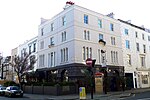Westbourne, London

Westbourne is an area west of Paddington in west London. It has a manorial history spanning many centuries, within a more broadly defined Paddington, before shedding its association in the mid-19th century. It is named after the west bourne, West Bourne, or River Westbourne, a Thames tributary which was encased in 19th-century London in the 1850s. The spring-fed stream and associated manor have led to the place names Westbourne Green, Westbourne Park and more narrowly: Westbourne Gardens, Westbourne Grove, Westbourne Park Road, Westbourne Park tube station, Westbourne Studios and the name of a public house. Westbourne forms or resembles an electoral ward of the local authority which is, since 1965, Westminster City Council, and an ecclesiastical parish in the Church of England. Westbourne Conservation Area is a smaller area, designated by the local authority, in Planning Law.
Excerpt from the Wikipedia article Westbourne, London (License: CC BY-SA 3.0, Authors, Images).Westbourne, London
Sutherland Place, City of Westminster Maida Hill
Geographical coordinates (GPS) Address Nearby Places Show on map
Geographical coordinates (GPS)
| Latitude | Longitude |
|---|---|
| N 51.516 ° | E -0.197 ° |
Address
Sutherland Place 35
W2 5BZ City of Westminster, Maida Hill
England, United Kingdom
Open on Google Maps









